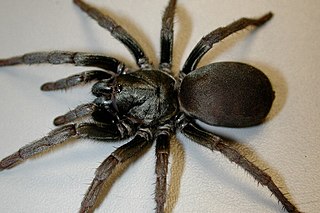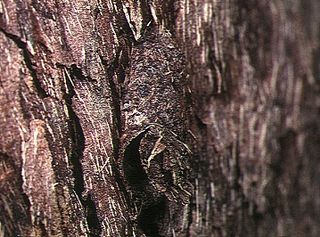
Nemesiidae, also known as funnel-web trapdoor spiders, is a family of mygalomorph spiders first described by Eugène Simon in 1889, and raised to family status in 1985. Before becoming its own family, it was considered part of "Dipluridae".

Sason is a genus of bark-dwelling brushed trapdoor spiders first described by Eugène Simon in 1887. It is distributed from the Seychelles through India to northern Australia. The closest related genus seems to be the monotypic Paracenobiopelma.

Tarantulas comprise a group of large and often hairy spiders of the family Theraphosidae. Currently, 1,010 species have been identified. The term "tarantula" is usually used to describe members of the family Theraphosidae, although many other members of the same infraorder (Mygalomorphae) are commonly referred to as "tarantulas" or "false tarantulas". Some of the more common species have become popular in the exotic pet trade. Many New World species kept as pets have setae known as urticating hairs that can cause irritation to the skin, and in extreme cases, cause damage to the eyes.

Idiops is a genus of armored trapdoor spiders that was first described by Josef Anton Maximilian Perty in 1833. It is the type genus of the spurred trapdoor spiders, Idiopidae. Idiops is also the most species-rich genus of the family, and is found at widely separated locations in the Neotropics, Afrotropics, Indomalaya and the Middle East. Females live in tubular burrows lined with a thick layer of white silk. These typically have a D-shaped lid that fits into the entrance like a cork, and some burrows have two entrances. The lid may consist of mud, moss or lichen, which is bound below by a thick layer of silk. As in all genera of this family, the anterior lateral eyes (ALE) are situated near the clypeal margin, far in front of the remaining six eyes, which are arranged in a tight group. The males which are smaller in size, wander about or occasionally live in burrows. Like other mygalomorphs, they are relatively large and long-lived. Forest clearance and agricultural practices that loosen the soil and enhance erosion, besides soil removal for brick making have been pointed out as serious threats to some Indian species. Species ranges are poorly known – in India for instance, most species are known only from their type localities.

Poecilotheria striata, or the Mysore ornamental tarantula, is a large arboreal tarantula of the family Theraphosidae. It is endemic to India.
Neoheterophrictus sahyadri is a spider species in the genus Neoheterophrictus. It was first described in 2012 by Manju Siliwal, Neha Gupta, and Robert John Raven. Its name "sahyadri" comes from the vernacular name for the Western Ghats, a mountain range in India where it was discovered.

Neoheterophrictus is a genus of tarantula in the family Theraphosidae. It comprises seven species, all found in India.
Neoheterophrictus bhori is a species of tarantula. It is native to Parambiculam, Western Ghats, Cochin province, India.
Neoheterophrictus crurofulvus is a species of tarantula. It is also the type species of Neoheterophrictus and is found in the Western Ghats, India.
The Eumenophorinae are a subfamily of tarantula spiders. They are known from genera distributed across Africa, southwestern countries in Saudi Arabia, and Madagascar and the associated islands.
Neoheterophrictus amboli is a species of theraphosid spiders, which is found in India.
Neoheterophrictus madraspatanus is a species of spider in the family Theraphosidae, found in India.
Diplothele halyi is a species of spider of the genus Diplothele. It is endemic to Sri Lanka. Differences from the type species Diplothele walshi include a large fovea and a less distinct abdominal pattern. The male is more hairy than female, with a slightly elevated spine. It was first described from the Nuwara Eliya area.
Diplothele is a genus of mygalomorph spider in the family Barychelidae, containing four species restricted to India and Sri Lanka.
Plesiophrictus is a genus of tarantulas that was first described by Reginald Innes Pocock in 1899.
Tigidia is a genus of brushed trapdoor spiders first described by Eugène Simon in 1892.

Conothele is a genus of mygalomorph spiders in the family Halonoproctidae, first described by Tamerlan Thorell in 1878. Originally placed with the Ctenizidae, it was moved to the Halonoproctidae in 2018.
Damarchilus is a genus of spiders in the family Nemesiidae. It was first described in 2015 by Siliwal, Molur & Raven. As of 2017, it contains 2 species, both from India.






